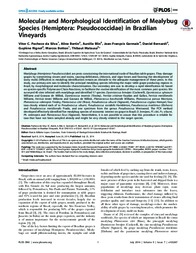Molecular and morphological identification of mealybug species (Hemiptera: Pseudococcidae) in Brazilian vineyards.
Molecular and morphological identification of mealybug species (Hemiptera: Pseudococcidae) in Brazilian vineyards.
Author(s): SILVA, V. C. P. da; BERTIN, A.; BLIN, A.; GERMAIN, J.-F.; BERNARDI, D.; RIGNOL, G.; BOTTON, M.; MALAUSA, T.
Summary: Mealybugs (Hemiptera: Pseudococcidae) are pests constraining the international trade of Brazilian table grapes. They damage grapes by transmitting viruses and toxins, causing defoliation, chlorosis, and vigor losses and favoring the development of sooty mold. Difficulties in mealybug identification remain an obstacle to the adequate management of these pests. In this study, our primary aim was to identify the principal mealybug species infesting the major table grape-producing regions in Brazil, by morphological and molecular characterization. Our secondary aim was to develop a rapid identification kit based on species-specific Polymerase Chain Reactions, to facilitate the routine identification of the most common pest species. We surveyed 40 sites infested with mealybugs and identified 17 species: Dysmicoccus brevipes (Cockerell), Dysmicoccus sylvarum Williams and Granara de Willink, Dysmicoccus texensis (Tinsley), Ferrisia cristinae Kaydan and Gullan, Ferrisia meridionalis Williams, Ferrisia terani Williams and Granara de Willink, Phenacoccus baccharidis Williams, Phenacoccus parvus Morrison, Phenacoccus solenopsis Tinsley, Planococcus citri (Risso), Pseudococcus viburni (Signoret), Pseudococcus cryptus Hempel, four taxa closely related each of to Pseudococcus viburni, Pseudococcus sociabilis Hambleton, Pseudococcus maritimus (Ehrhorn) and Pseudococcus meridionalis Prado, and one specimen from the genus Pseudococcus Westwood. The PCR method developed effectively identified five mealybug species of economic interest on grape in Brazil: D. brevipes, Pl. citri, Ps. viburni, Ph. solenopsis and Planococcus ficus (Signoret). Nevertheless, it is not possible to assure that this procedure is reliable for taxa that have not been sampled already and might be very closely related to the target species.
Publication year: 2014
Types of publication: Journal article
Unit: Embrapa Grape & Wine
Keywords: Cochinilha, Mealybug, Praga de planta, Uva, Uva de mesa, Vineyard, Vinhedo
Observation
Some of Embrapa's publications are published as ePub files. To read them, use or download one of the following free software options to your computer or mobile device. Android: Google Play Books; IOS: iBooks; Windows and Linux: Calibre.
Access other publications
Access the Agricultural Research Database (BDPA) to consult Embrapa's full library collection and records.
Visit Embrapa Bookstore to purchase books and other publications sold by Embrapa.

